#halley's otome history notebook
Explore tagged Tumblr posts
Text
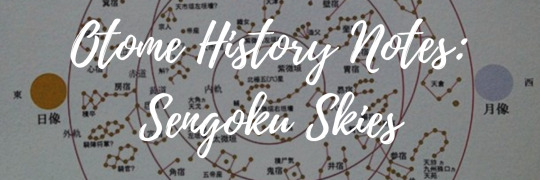
Not-so-long-long-ago in a discord server not-so-far-away I witnessed a question.

As a space nerd and aspiring anthropologist I just couldn't ignore the question of constellations around the world. Guys, gals, and non-binary pals this is a special episode of the otome history notebook where we cover a more scientific/cultural/history note as opposed to straight up history, so buckle your seatbelts and get ready to read about a most interesting topic: how people view the stars above.

If you were to stand on the North Pole exactly and look up at the stars, you'd see a portion of the sky rotating around a point directly above you. You'd never see the sky someone standing on exactly the South Pole would, although the sky you would see would also be rotating around a point on the pole.
The parts of the sky we can see change as you move down Earth's longitudes, so although there'd be some overlap in say, the sky you'd see in Chile vs the sky you'd see in Arizona, they would certainly be different. Along latitudes, however, you'd be able to see the same sky as someone else along that latitude would see at a different point in Earth's rotation (which is to say, a different time of the year).

Although there are differences along longitudes in what part of the sky we view, there's overlap. And of course, along longitudes people see the same part of the sky at different times of year. This should mean that a lot of different places can see the same constellations as you do, right? Wrong.
Different cultures have been able to look at the same star for millions of years, yet through storytelling connect that star to those around it in such different ways. Take Betelgeuse for example; in my home country of Canada the settlers brought stories of Orion, but the Inuit and Ojibwe peoples saw something entirely different when looking at that same general clump of stars. So did the Egyptians, so did the Chinese, and the Tupi.
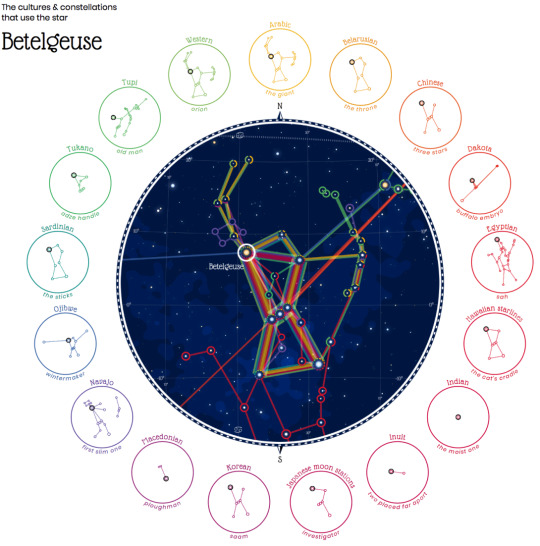
If you take a closer look at this diagram you'll see a little bubble labeled "Japanese moon stations". Hold up, does Japan have different constellations? Well, not in the modern day. Western constellations have become pretty standard worldwide, but in pre-Meiji era Japan there were indeed different constellations.

Before the Meiji era, astronomical observations were mainly for astrological purposes. These "astrological purposes" are the 28 lunar stations/lodges/mansions Japan derived from Chinese astrology. To be fair, China derived it's 28 lunar stations from Middle Eastern and Hindu astrology where they are Also A Thing. It just kinda became a big domino line across all of Asia that said "You know what we should do? Base our astrological divinations off of the lunar cycle".
The lunar mansions are divided up into four clusters, each made up of seven constellations. They're divided into four clusters because of the four cardinal directions. In China the four cardinal directions are associated with the Chinese emblems. The Chinese embelems are the tortoise for the north, the white tiger for the west, the phoenix for the south, and the dragon for the east.
However in Japanese astrology they're replaced with Four Heavenly Kings of Buddhism (or Shitenno, 四天王) that also guard the four cardinal directions.
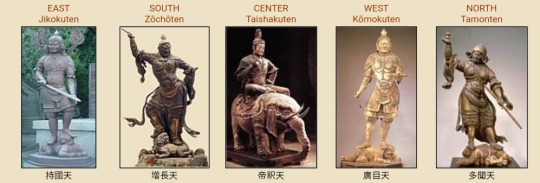
The 28 lodges themselves, are often represented in the astral mandalas of the Big Dipper Mandala (Hokuto Mandara, 北斗曼荼羅) and the Star Mandala (Hoshi Mandara, 星曼荼羅). These mandalas are associated with Japan's Esoteric Buddhist sect. When Chinese astrological lore was first introduced in Japan the Shingon and Tendai schools of the Esoteric sect were the most receptive.
Here you can see the constellations themselves drawn alongside the 28 celestial maidens.
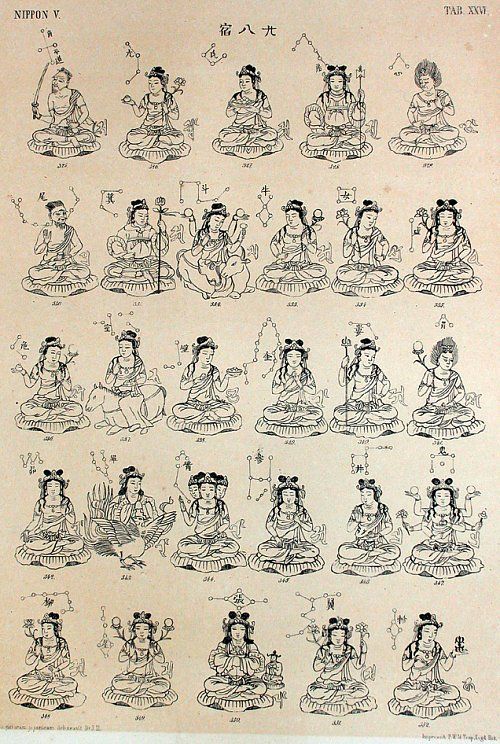
I can hear the echo of Shingen's pickup lines from here.
I won't go into the Japanese names of the constellations, because apparently they can differ and I can't find a source that definitively matches names to the actual constellations as a visual at the moment. Maybe I'll make a follow-up post? Who knows.
In the meantime, you can rest easy knowing that this was how the people of the Sengoku era told their stories of the stars.🌠
Join the Otome History Notes discord server!
Disclaimer: I am not a historian, and I don't have access to like actual archives or anything. Pls correct me if anything I said here was wrong.
S O U R C E S
55 notes
·
View notes
Text
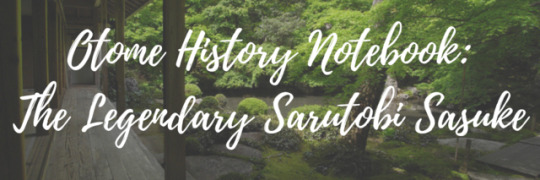
I'm back babey! This is it folks. Tomorrow's the day Ikemen Sengoku's Sasuke aka the love of my life gets his EN route. To celebrate, I wanted to look into the OG Sasuke. The mans our mans was named after.
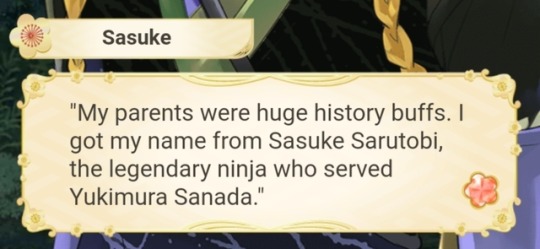
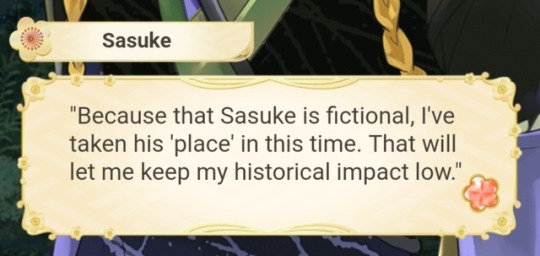
In honor of this momentus route release and reaching 200 followers I will delve deep into the lore of the man, the myth, the legend: Sarutobi Sasuke.

The Sanada Ten Braves, aka juyushi (真田十勇士) or Ten Heroes of Sanada, are as you probably know after playing ikesen long enough a legendary group of ninjas that served Sanada Yukimura and were led by Sasuke. As for their names ya got...
Sarutobi Sasuke (猿飛佐助)
Kirigakure Saizo (霧隠才蔵)
Miyoshi Seikai (三好清海)
Miyoshi Isa (三好伊三)
Anayama Kousuke (穴山小助)
Unno Rokuro (海野六郎)
Kakei Juzo (筧十蔵)
Nezu Jinpaichi (根津甚八)
Mochizuki Rokuro (望月六郎)
Aaaaaaaand
Yuri Kamanosuke (由利鎌之助)
The story of the Sanada Ten Braves was first recorded in Tatsukawa Bunko (立川文庫), a series of children's books written during the Taisho period (大正時代, 1912-26). The stories that made up Tatsukawa Bunko were made up by professional storyteller Gyokushusai Tamada (玉秀斎玉田).

So anyways, when you get down to it the OG Sasuke's character was thought to be a fusion of historical and fictional accounts of Ninja and the literary hero from Journey to The West, Sun Wukong: the monkey king. HOWEVER, recently there had been a lot more room for doubt that Sun Wukong was chosen as a model for Sasuke. There's also various other theories about real-life figures that could've been an inspiration. Ya got ninjas like Kozui Sasuke (上月佐助): master of Iga ninjutsu, Sarutobi Nisuke (猿飛仁助), or Mikumo Sasuke (三雲佐助) who was an extant Koga-ninja (甲賀忍者) who worked under the Toyotomi family if you've read Sasuke's JP route or spoilers for it then you're probably also freaking about this little easter egg.
The original Sasuke wasn't a whole lot like our ikesen Sasuke. He fit the general genki stereotype character with some mischief thrown in there to keep things interesting, and was an anti-hero who used his powers for good. Said powers were crazy Naruto-style jutsu.
So here's how things went down for Sasuke:
Deep in the mountains of Shinano (信濃) (now Nagano prefecture) born and raised, playing with monkeys (I mean it suits him, sarutobi literally means monkey jump) is how he spend most of his days (also probably where he got his "monkey-like agility"). Then one day he comes across a mysterious ninja master of Koga ninjutsu (甲賀忍術), allegedly while he was practice sparring with a tree, who laughs at his tree fighting and agrees to teach him some mad ninja skillz. Later he meets a theif who knows ninjutsu: Kirigakure Saizo. Honestly, this Saizo is a lot like his slbp counterpart. A sharp contrast to this Sasuke, who's basically just your average shonen protagonist. Obviously, they gotta become rivals. They battle it out and Sasuke ends up winning. After that the two of them join Yukimura's ninja avengers (the Braves). Seriously. Yuki is the Nick Fury to their avengers. They all have Naruto-esque superpowers. Eventually they fought for the Toyotomi army against Ieyasu at the siege of Osaka, only to lose. What happened to Sasuke and the Braves? Their fates were never revealed. What a shitty ending. But fear not! There's an alternate ending!... In which Sasuke gets his foot caught in a bear trap while trying to infiltrate Ieyasu's stronghold. Then he...... Realizes he couldn't complete his mission and he.... Kills himself. No happy ending here I guess, only ones that remind me of that one lyric from actual cannibal Shia LaBeouf.

THIS DUDE. Has SO MUCH SHIT NAMED AFTER HIM. AND HE AIN'T EVEN REAL.
Tatsukawa Bunko began a ninja boom in Japanese pop culture. The forerunner of this was the character who would become synonymous with ninja: Sasuke. You've got...
Smol 80s Steven Universe Sasuke

Yu-Gi-Oh card robo-Sasuke

Mitsuhide-lookin Sasuke

The OG wipeout style game show was LITERALLY CALLED SASUKE

He is everywhere. There is no escape.
Disclaimer: I am not a historian, my japanese skills are mediocre at best, and I don't have access to like actual archives or anything. Pls correct me if anything I said here was wrong.
S O U R C E S
77 notes
·
View notes
Text

It's July 7th! And you know what that means: Yukimura's birthday! (Image creds to Cybrid)

But it also means Tanbata. What is Tanbata you ask? Well...

Tanabata (七夕) is also known as the star festival, and is a celebration that commemorates a tale of two lovers. The two lovers in this tale are represented by two stars: Vega and Altair, allowed to meet but once a year so long as the skies remain clear. This story of Tanabata was adapted from the Chinese legend of Qixi, which was brought to Japan in the 8th century.
Traditionally, it was celebrated on the 7th day of the 7th lunar month, which in accordance with the old Chinese calendar is on August 7th. On the modern calendar it's typically celebrated on July 7th. However, some places in Japan still celebrate it in August. In fact the most famous of Japan's Tanabata festivals in Sendai is on August 7th.

The story of Tanabata has varied through different tellings over the years, but here's the gist:
There was once a princess who was also a seamstress (oh wow sounds like MC) named Orihime (織姫). She's represented by Vega. Orihime was really good at what she did, weaving clothes by the heavenly river (represented by the milky way), but she was also a workaholic who was sad about how her own workaholic-ness took away her chances of ever finding love. So her dad, a god of the heavens, arranges for her to meet this cow herder dude named Hikoboshi (彦星) from the other side of the milky way. He's represented by Altair.
Hikoboshi and Orihime instantly fell madly in love, got married, and proceeded to neglect their respective jobs. Orihime's dad was not impressed with this and forbade them to be together. Then Orihime pulled the ol' 'pretty-please-with-a-cherry-on-top?' and her dad relented and allowed them to meet once a year, on the 7th day of the 7th lunar month. All good, right? Wrong.
The first time that day came around for our star-crossed cosmic lovers they found the milky way river hella difficult to cross. Whilst wallowing in her despair at this, Orihime in classic folkloric princess fashion attracted a flock of birds (magpies to be exact) to help her. The magpies made a bridge to allow the two lovers to reach each other easier. However, it is said that if it rains on Tanabata the magpies won't make their weird bird bridge and the lovers can't have their annual reunion. Therefore, the Japanese people always hope for clear skies on Tanabata, lest the lovers be unable to reunite.

The big custom that is performed when celebrating Tanabata is the tying of wishes written on slips of coloured paper (tanzaku, 短冊) to bamboo trees. These trees are wish trees, and the day after Tanabata they're floated on a river (or if you're on the coast an ocean) and BURNED AS AN OFFERING. Other decorations are hung on the trees too, such as colourful origami streamers.


In addition to the wish trees there's also the typical matsuri stuff on the day/night of Tanabata. You know, parades, food stalls, fireworks, etc. Oh! And there's a children's song! As I mentioned earlier, the most well known of these Tanabata festivals is in Sendai. Have some footage of it:
youtube
youtube
JOIN THE OTOME HISTORY NOTES DISCORD SERVER!!!
Disclaimer: I am not a historian, nor have I ever attended a Tanabata festival or lived in Japan. Pls correct me if anything I said here was wrong.
S O U R C E S
30 notes
·
View notes
Text

So uhhhh..... This is a thing now
Join today!
If you don't know what this is about, I must direct you to this post.
6 notes
·
View notes
Text

Okay so let's talk about armies. Let's talk about armor. Let's get some things straight.

Just who were the Akazonae (赤備え)?

Akazonae refers to both the red armor that became Yukimura's trademark, and the Takeda army. Why is it so significant that that there big ol' suit of not-get-your-organs- stabbed-out material was red? I'll get to that later.

This^ is a reproduction of the sort of armor Yukimura would've worn. No one knows where his actual suit of armor is, or if it even survived. Either way, it became one of the things he was known for (despite the rest of the Takeda forces also being red-clad).

The supposed reasoning behind the Takeda forces wearing red is that it stands out. And if you stand out on the field, there's nowhere to hide. Ergo, your total lack of camouflage encourages you to be bold and attack first, lest you hold back and get trampled (because literally everyone knows your position).
Can't argue with that logic. ¯\_(ツ)_/ ¯
By putting the entire army in said colour, it was a way to show unity within the troops. In addition to this, red was (and still is) a rather culturally important colour in Japan, which demonstrated the unit's elite status.

Here's the Sanada army^ donning their trademark colour on the Summer Siege of Osaka Panel Screen in Osaka Castle

The specific shade of red that was associated with Akazaone armor was vermillion, or shuiro (朱色), which is the colour you always see shrine archways painted with.

Red was associated with the sun, which in "the land of the rising sun", gave it great importance in regards to cultural identity.
S O U R C E S
#halley's otome history notebook#ikemen sengoku#ikesen yukimura#sanada yukimura#ikesen#japanese history#ikesen nw
145 notes
·
View notes
Text

Because don't we all want to know more about Kenshin's sword ( ͡° ͜ʖ ͡°)

Turns out there's a pretty neat story behind the name Himezuru Ichimonji (姫鶴一文字)

Let's start with a little bit about where the sword came from in the first place. The "Ichimonji" part of the name.
The Ichimonji school of bladesmithing came about in the early Kamakura period out of Bizen province (currently the southern part of Okayama prefecture), and lasted through the Nanbokucho period.

Where Bizen was^
The works of the Ichimonji smiths were trademarked by the inscription of the character for one, "ichi" (一) on them. In most (but not all) cases that's all a smith would sign the blade with.
The Ichimonji featured in this post is a Ko-ichimonji (古一文字), or literally, "early ichimonji". These were made by the Ko-bizen (古備前) or "early Bizen" school of Ichimonji, which spanned from the early to mid Kamakura period. This means Kenshin's Ichimonji would've been about 200 years old at the start of the Sengoku era, which isn't a huge stretch considering the passing of heirlooms and the exceptionally well make of Ichimonji blades.
For more info on the Ichimonji school look here, for more info on the time periods mentioned look here.

The story began one evening, when Kenshin decided he wanted his sword shortened. He went straight to the official Uesugi sword polisher (known as the togi-shi, 研師). It was too late to really get started on anything, so the sword polisher just promised he'd get to it as soon as possible. Kenshin shuffled off out of the fife to take care of some business, the sword polisher shuffled off to bed.
That night, the sword polisher saw a princess in his dreams, begging him not to hurt her. How did he know she was a princess? Don't ask me, she probably just looked like one. The princess was in tears, pleading the sword polisher not to hurt her.
The next morning, the polisher was still a little shaken up from the dream and saved Kenshin's sword for last. When he finally did get a start on filing down the tang (see diagram of sword at bottom of post), he didn't really affect the length at, because by the time he got to it it was once again time to punch the clock. She showed up again in his nightmares that night, this time begging him to stop hurting her. He asked her for her name, and she replied Tsuru.
The next day, the polisher decided he needed to seek some help for all this supernatural craziness, so he went to the guy in charge of the swords for the fife (known as the on-koshimono, 御腰物). As fate would have it, the two of them had the same dream about princess Tsuru, and came to the conclusion that it had something to do with Kenshin's sword, and that they should probably consult Kenshin about it before they pulled some horror movie shit and brought down some sort of divine wrath from whatever spirit inhabited the sword.
In the end, the blade was left as it was, and named with the characters "hime" (姫), meaning princess, and "Tsuru" (鶴, pronounced "zuru" when combined with 姫), her name.

School: Ichimonji, Ko-bizen, Mei
Type: Tachi
Nagasa: 71.66cm
Sori: 2.3cm
Full profile

Nowadays Himezuru can be found in the Yonegawa City Uesugi Museum

There she is^
S O U R C E S
#halley's otome history notebook#ikesen#ikemen sengoku#ikesen kenshin#uesugi kenshin#japanese history#ikesennw
123 notes
·
View notes
Text
SO I just found out Netflix had a really interesting documentary about Go called The Surrounding Game
So yeah, y'all can go check that out


Has a wormhole ever yote you back to medieval Japan? Has Oda Nobunaga ever challenged you to a game of go with your body and even- great Scott, Marty- your only shot at getting back to the future on the line? Do you have no idea how to play?
Look no further!

Go (also know as igo) was supposedly invented about 4000 or so years ago in China. As a simple statement that probably sounds pretty boring but LET ME TELL YOU that is insanely old for a board game. It’s referenced in both the analects of Confucius and The Tale of Genji (which is thought to be one of the world’s first novels, written during the Heian era). The earliest theorized date for the game’s creation, 2356 BCE, is only about 750 years after the invention of Senet in Egypt, which is thought to be the first known board game. It’s so damn old that it’s even been embedded into the lore of the mythological Emperor Yao. Legend claims he invented the game to enlighten his son, Dan Zhu.

Senet board inscribed for Amenhotep III^ (Brooklyn museum collection)
As most of the oldest board games were, Go was a pastime for members of higher society who actually had enough free time to warrant having a hobby (unlike peasants, working with the latest push-plow technology to try and put the live in livelihood). This really makes sense with how the game took off in Japan. It is thought to have been taken to Japan around 500 CE via the Korean Peninsula, and popularized during the Heian period (794-1185 CE). The Heian period is characterized by it’s aristocracy, the cultural achievements of that aristocracy, and their less than effective governance. Wanna go run the country? Nah. Let’s just make some art, play some board games, and obsess over the status of a mere fraction 1% of the population. ¯\_(ツ)_/ ¯

Heian aristocrats playing some go^
The modern version of the game emerged with the rise of the samurai class, spreading to the samurai themselves and the Buddhist priesthood throughout the Sengoku era. During the Edo period four schools of Go were established and supported by the government, giving Go-playing status as an actual profession. The first head of the Honinbo school, Sansa (1559-1623), taught Nobunaga, Hideyoshi, and Ieyasu how to play. Sansa was the head of the state Go academy (Godokoro) and was the one who established the four schools: Honibo, Yasui, Inoue, and Hayashi. Throughout the edo era the four schools would compete to play at Edo castle in front of the Shogun.

For a game often referred to as the ultimate strategy game, the rules of Go are really simple. However, there are variations between the Japanese and Chinese rules. I’ll be covering just the basic rules here.
A typical Go board (or goban) comes in three standard sizes: 19×19, 13×13, or 9×9.

Each player begins with an effectively unlimited supply of stones. The objective is to take territory on the board by surrounding it with your stones. When a stone is surrounded and captured it is removed from the board. Black always goes first. You probably know that much if you’ve played Nobunaga’s route.

An example of capture^
As pictured above, stones are placed not in the squares, but on the intersections of the board. At the end of the game players count one point for each vacant point within their territory, and one point for every stone they’ve captured. And since this isn’t golf, the player with the most points wins.
Your stones have liberties horizontal and vertically adjacent to them. If all the liberties are occupied on a stone or a string of stones, they are captured. Strings of stones can only be vertical or horizontal, never diagonal, and are treated as a single unit. Several strings clumped together are described as a group.

Here we can see the liberties of these stones marked with x’s^
For situations, strategies, and a more in depth look at the rules you can read this.
S O U R C E S
80 notes
·
View notes
Text

And his swashbuckling adventures!!
We don't know much about Pirate McTrickster, save for the fact that he's a little shit and a... Uhhhh....

Aku no hana (悪の華)? Villainous flower? Flower of evil? Idek but the other thing says kaizoku (海賊) and that means pirate, so let's roll with that and check out what the deal was with the real slim shady by the sea Motonari.

Mori Motonari (毛利元就), childhood name Shojumaru (松寿丸), started out as the second son of Mori Hiromoto, a local daimyo struggling for power in Aki prefecture. However, he would go on to make a name for himself as a brilliant warlord, strategist, and master of sneakiness.
The Mori clan claimed descendance of Oie Hiromoto, advisor to Minamoto Yoritomo, the first Kamakura Shogun. The territory they held since 1336 was in Aki Province, and the castle they had used as headquarters since the early 14th century was named Koriyama.

Here you can see Aki Province (安芸国)^, now part of Hiroshima Prefecture.
Koriyama Castle is no longer standing, however there are around 130 relics still left on the castle site. More about that for any fellow archaeology nerds here and here. If you Google Koriyama Castle you're most likely going to see the other Koriyama Castle in Nara Prefecture (no ties to the Mori).
The territory the Mori held during Motonari's childhood was under constant threat from a barrage of enemies, including the Aki branch of the Takeda (led by Takeda Motoshige), the Oûchi clan, and the Amako. In 1506 Motonari's father died, passing the clan's succession onto his eldest son Okimoto. Just 10 years later Okimoto died of quote un-quote "unclear circumstances", leaving his still-too-young-to-rule son (Komatsumaru) under the care of Motonari. 7 years after that Komatsumaru also died of "unclear circumstances".
Look.
This is the Sengoku Era we're talking about.
Most family drama ends with a pile of corpses.
I'm not saying that those "unclear circumstances" were named Motonari... But he did have a lot to gain from it... And... It is a rather popular theory that he dispatched them himself...
Anyhow, Motonari went on to lead the Mori quite well through their ups and downs. He won some battles, he lost some battles. He expanded the Mori's territory quite a bit. got married and had some sons to become his pawns* successors. He made alliances (including one with the former enemy clan of Oûchi), he lost alliances (yeah, the thing with the Oûchi didn't last).
Now I know what you're thinking. Where are the pirates? Well. All this talk of alliances really ties in nicely to the battle on the waves that gave Motonari his stripes as a naval officer. Let's get on with it, shall we?
*Tbh he used them to play kingmaker and eventually manipulated it so that his second and third sons became the heads of other clans.

I mentioned that Motonari allied himself with the Oûchi, right? Yeah. He did that pretty early in his career. Like, before they finally betrayed him and made this battle a thing the Oûchi went through three clan leaders. The second of which, Oûchi Yoshitaka, did what I like to think of as the Sengoku equivalent of the time Shia LaBeouf showed up on the red carpet with a bag over his head that said "I'm not famous anymore" (lost a battle, retreated into court life, and got wayyy too into the tea trade and wayyy too out of military affairs). Eventually, his general Sue Takafusa got so tired of Yoshitaka's shit he staged an uprising. Then Sue installed Oûchi Yoshinaga as head of the clan, changed his name to Sue Harukata, and basically ran the clan's military. Well, he ran the show before he made Yoshitaka commit seppuku too because during his midlife crisis Yoshitaka was about as shoes are to a hobbit.
Meanwhile, Motonari was expanding his territory by paying irl risk with his sons and allying himself with some pirates (the Murakami clan, 村上氏). Neither Sue nor Motonari trusted each other, so Motonari bided his time and strengthened his ties with the Murakami, all while paying lip service to Sue until he was strong enough to cut ties with the Oûchi. Their joint-conquests were depleting his resources and he wanted a little vengeance on Sue for killing his old ally. Once he did break it off, Sue gathered an army of 30 000 men (which Motonari could barely get half of), and launched an attack at Oshikibata... Which failed because Motonari bribed a bunch of Sue's soldiers.
Then, in 1555, Sue threatened Motonari into a brilliant scheme that would make everyone say

It happened on Miyajima island. The entirety of which was a Shinto shrine, and no births or deaths were supposed to happen on it.

You may know it today as Itsukushima: home of that shrine you see on postcards a lot.^
Seems like the perfect place to build an easily conquerable castle to tempt the Oûchi into a trap. Miyao castle was constructed on Miyajima, facing the mainland on a hill. Perfectly attackable, yet in a spot that would supposedly allow Sue to take back the land peppering the inland sea that Motonari's naval forces patrolled. Then there's Sakurao castle (on the mainland near the island), which was initially within Mori territory, but Motonari got the vassal holding Sakurao to fake defection to Sue's side. It was believable to Sue, because said Mori vassal fought against Motonari during his succession as clan heir. What made it such a trap was the fact that if Sue were to take the bait on Miyajima, the Mori could swoop down and take back Sakurao castle on the mainland, effectively surrounding Sue on the island and using the Mori's naval forces (which were much stronger than Sue's) to take Miyajima back.
Sue fell for it and took Miyao Castle. The night before Motonari's attack, he sent over a ship of fake Sue forces, who found and cut off Miyao's water supply. Motonari's third son, Kobayakawa Takakage, sailed straight towards Miyao Castle as a distraction, starting during the day. At night, a fleet of local Murakami pirates had agreed to transport Motonari's troops to the island, and did so in a thunderstorm, obscuring their approach. Motonari, his second son Kikkawa Motoharu, and his eldest son Mori Takamoto went around the east side of the island to Sue's rear guard.
The next morning son #3 launched a land assault on the front gate, while Motonari with sons #'s 1 and 2 militarily butt-fucked Sue's forces from the rear. The day was won with both territory and a reputation gained.

Here's a poorly made map of how it went down^
Fucking superb you funky little pirate.

Now here's a heartwarming story for the ages that'll really get you to like this guy. (Discalimer, no one knows for sure if this was actually true, but it's pretty widely circulated nonetheless).
On Motonari's deathbed he handed each of his three sons an arrow, and told them to snap it. The three sons snapped the arrows easily. He then brought out a bundle of three arrows and asked them to snap it. When they couldn't, he replied that while one arrow may break easily, three held together? Not so much. The same was true with the brothers. If they stood together they would be stronger. To turn on each other, as families often did in the Sengoku, would be to destroy what they built together as the Mori.
The story is still taught today to Japanese schoolchildren, because teamwork and stuff.
S O U R C E S
#halley's otome history notebook#ikemen sengoku#mori motonari#ikesen#ikesen motonari#japanese history#sorry this is so long im a rambling nerd#ikesen nw
34 notes
·
View notes
Text
Uhhhh... Hi
I'm almost at 200 followers and I'm baffled that that many of you like my dumb memes or my history posts I used to make, do y'all want those to come back?
But anyway, I want to do something to celebrate the milestone but have no idea what. Ideally I'd do something sasuke themed since his EN route was just announced buuuuut ¯\_(ツ)_/¯ pls reply with what you'd like to see
OPTIONS:
Sasuke themed crack compilation
Revealing the face of the Halley
Bringing back Halley's otome notebook with a post on the legend of Sarutobi Sasuke
14 notes
·
View notes
Text

Hi. I like otome games. I like history. I like to make informative edits that combine the two. Welcome to Halley's Otome History Notebook!!!

Himezuru Ichimonji
The Akazaone
Mori Motonari
The Rules and History of Go
Sarutobi Sasuke and The Sanada Ten Braves
Sengoku Skies?
July 7th, Tanabata

Count St. Germain (coming soon)
Disclaimer: I am not a historian, nor do I speak Japanese fluently. Good english sources are hard to find and it's difficult for me to translate Japanese sources. If I get something wrong please tell me.
JOIN THE OTOME HISTORY NOTES DISCORD SERVER
26 notes
·
View notes
Text
Reblogging bc of the current event (^▽^)

Because don’t we all want to know more about Kenshin’s sword ( ͡° ͜ʖ ͡°)

Turns out there’s a pretty neat story behind the name Himezuru Ichimonji (姫鶴一文字)

Let’s start with a little bit about where the sword came from in the first place. The “Ichimonji” part of the name.
The Ichimonji school of bladesmithing came about in the early Kamakura period out of Bizen province (currently the southern part of Okayama prefecture), and lasted through the Nanbokucho period.

Where Bizen was^
The works of the Ichimonji smiths were trademarked by the inscription of the character for one, “ichi” (一) on them. In most (but not all) cases that’s all a smith would sign the blade with.
The Ichimonji featured in this post is a Ko-ichimonji (古一文字), or literally, “early ichimonji”. These were made by the Ko-bizen (古備前) or “early Bizen” school of Ichimonji, which spanned from the early to mid Kamakura period. This means Kenshin’s Ichimonji would’ve been about 200 years old at the start of the Sengoku era, which isn’t a huge stretch considering the passing of heirlooms and the exceptionally well make of Ichimonji blades.
For more info on the Ichimonji school look here, for more info on the time periods mentioned look here.

The story began one evening, when Kenshin decided he wanted his sword shortened. He went straight to the official Uesugi sword polisher (known as the togi-shi, 研師). It was too late to really get started on anything, so the sword polisher just promised he’d get to it as soon as possible. Kenshin shuffled off out of the fife to take care of some business, the sword polisher shuffled off to bed.
That night, the sword polisher saw a princess in his dreams, begging him not to hurt her. How did he know she was a princess? Don’t ask me, she probably just looked like one. The princess was in tears, pleading the sword polisher not to hurt her.
The next morning, the polisher was still a little shaken up from the dream and saved Kenshin’s sword for last. When he finally did get a start on filing down the tang (see diagram of sword at bottom of post), he didn’t really affect the length at, because by the time he got to it it was once again time to punch the clock. She showed up again in his nightmares that night, this time begging him to stop hurting her. He asked her for her name, and she replied Tsuru.
The next day, the polisher decided he needed to seek some help for all this supernatural craziness, so he went to the guy in charge of the swords for the fife (known as the on-koshimono, 御腰物). As fate would have it, the two of them had the same dream about princess Tsuru, and came to the conclusion that it had something to do with Kenshin’s sword, and that they should probably consult Kenshin about it before they pulled some horror movie shit and brought down some sort of divine wrath from whatever spirit inhabited the sword.
In the end, the blade was left as it was, and named with the characters “hime” (姫), meaning princess, and “Tsuru” (鶴, pronounced “zuru” when combined with 姫), her name.

School: Ichimonji, Ko-bizen, Mei
Type: Tachi
Nagasa: 71.66cm
Sori: 2.3cm
Full profile

Nowadays Himezuru can be found in the Yonegawa City Uesugi Museum

There she is^
S O U R C E S
123 notes
·
View notes
Text

Has a wormhole ever yote you back to medieval Japan? Has Oda Nobunaga ever challenged you to a game of go with your body and even- great Scott, Marty- your only shot at getting back to the future on the line? Do you have no idea how to play?
Look no further!

Go (also know as igo) was supposedly invented about 4000 or so years ago in China. As a simple statement that probably sounds pretty boring but LET ME TELL YOU that is insanely old for a board game. It's referenced in both the analects of Confucius and The Tale of Genji (which is thought to be one of the world's first novels, written during the Heian era). The earliest theorized date for the game's creation, 2356 BCE, is only about 750 years after the invention of Senet in Egypt, which is thought to be the first known board game. It's so damn old that it's even been embedded into the lore of the mythological Emperor Yao. Legend claims he invented the game to enlighten his son, Dan Zhu.

Senet board inscribed for Amenhotep III^ (Brooklyn museum collection)
As most of the oldest board games were, Go was a pastime for members of higher society who actually had enough free time to warrant having a hobby (unlike peasants, working with the latest push-plow technology to try and put the live in livelihood). This really makes sense with how the game took off in Japan. It is thought to have been taken to Japan around 500 CE via the Korean Peninsula, and popularized during the Heian period (794-1185 CE). The Heian period is characterized by it's aristocracy, the cultural achievements of that aristocracy, and their less than effective governance. Wanna go run the country? Nah. Let's just make some art, play some board games, and obsess over the status of a mere fraction 1% of the population. ¯\_(ツ)_/ ¯

Heian aristocrats playing some go^
The modern version of the game emerged with the rise of the samurai class, spreading to the samurai themselves and the Buddhist priesthood throughout the Sengoku era. During the Edo period four schools of Go were established and supported by the government, giving Go-playing status as an actual profession. The first head of the Honinbo school, Sansa (1559-1623), taught Nobunaga, Hideyoshi, and Ieyasu how to play. Sansa was the head of the state Go academy (Godokoro) and was the one who established the four schools: Honibo, Yasui, Inoue, and Hayashi. Throughout the edo era the four schools would compete to play at Edo castle in front of the Shogun.

For a game often referred to as the ultimate strategy game, the rules of Go are really simple. However, there are variations between the Japanese and Chinese rules. I'll be covering just the basic rules here.
A typical Go board (or goban) comes in three standard sizes: 19×19, 13×13, or 9×9.

Each player begins with an effectively unlimited supply of stones. The objective is to take territory on the board by surrounding it with your stones. When a stone is surrounded and captured it is removed from the board. Black always goes first. You probably know that much if you've played Nobunaga's route.

An example of capture^
As pictured above, stones are placed not in the squares, but on the intersections of the board. At the end of the game players count one point for each vacant point within their territory, and one point for every stone they've captured. And since this isn't golf, the player with the most points wins.
Your stones have liberties horizontal and vertically adjacent to them. If all the liberties are occupied on a stone or a string of stones, they are captured. Strings of stones can only be vertical or horizontal, never diagonal, and are treated as a single unit. Several strings clumped together are described as a group.

Here we can see the liberties of these stones marked with x's^
For situations, strategies, and a more in depth look at the rules you can read this.
S O U R C E S
80 notes
·
View notes